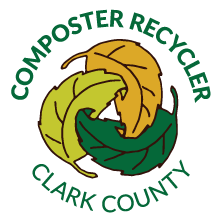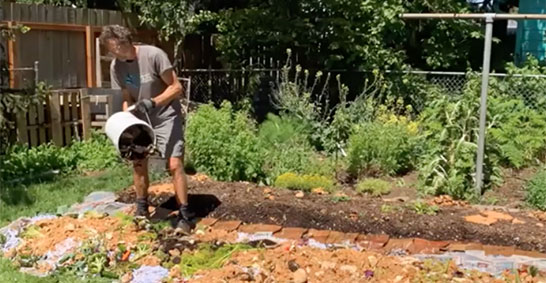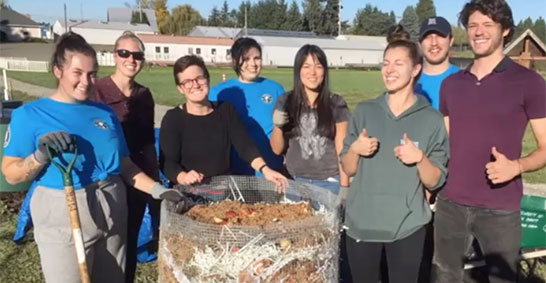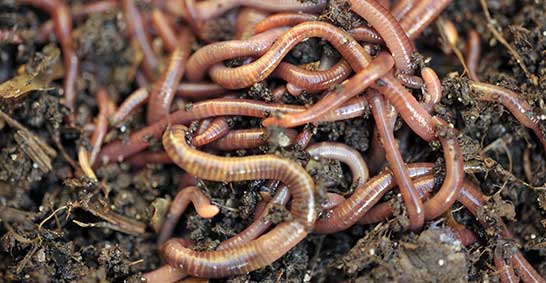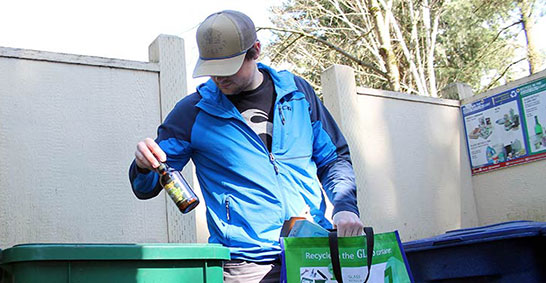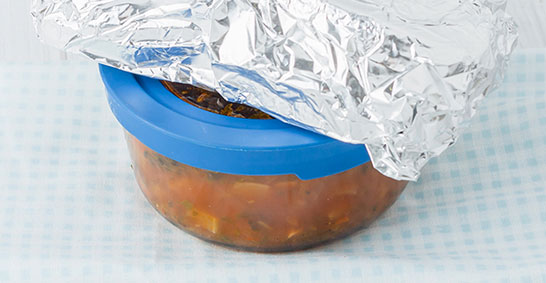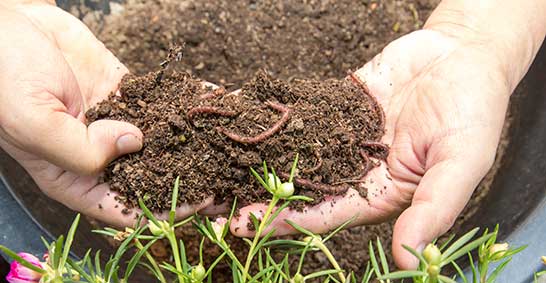Backyard Composting FAQs
-
What is the best way to turn a bin?
A pitchfork, wingdinger, and shovel are all good tools to use to turn the bin. It’s more about what you prefer and works best for you.
-
How often do you need to turn your bin?
It depends on what kind of composting you are doing. If you are “hot” composting, it is recommended to turn the bin once a week to aerate your material until it no longer smells and starts to look like crumbly earth.
-
Does turning the bin speed up the process because it adds more air?
Turning the bin helps to add more air and better mix the materials.
-
How can you gather and store composting greens and browns?
Browns: Collect leaves in the fall from your yard or around the neighborhood and store them in bags or containers that keep them dry. Collect old newspapers from a local library, a local newspaper office, friends and family, Buy Nothing on Facebook, or other creative sources. Collect cardboard boxes from large retailers, liquor stores, bookstores, grocery stores, offices, someone in the area who just moved, etc.
Greens: Collect your personal food scraps. Ask a local coffeeshop if you can regularly pick up old coffee grounds. Become a site on sharewaste.com or makesoil.org so that neighbors arrange to drop off their food scraps.
-
What are the benefits of putting in coffee grounds and tea leaves?
Coffee grounds and tea leaves are both high in nitrogen and other nutrients. These count as greens.
-
Is it okay to put cooked food scraps in your bin?
It is not recommended to put cooked food scraps in as they may contain oil, grease, sauces, etc. These can be hard to break down and may attract pests.
-
Can you use shredded paper?
Laser toner and printer paper should be avoided, same with glossy prints, as they use synthetic polymers to bind the ink to the page. Newspaper is fine for compost as they use vegetable based inks for printing.
-
Can you put raw livestock manure directly into your pile or does it already have to be aged before adding?
Fresh manure can go directly into a compost bin / pile.
- At this time, the FDA does not object to farmers complying with the USDA’s National Organic Program standards
- 120-day interval between the application of raw manure for crops in contact with the soil
- 90 days for crops not in contact with the soil.
-
Can you put in shiny paper, such as flyers or magazines?
Glossy prints use synthetic polymers to bind the ink to the page and should be avoided. Newspaper is fine for compost as they use vegetable based inks for printing.
-
Is it okay to put in grass clippings or plants that have been exposed to chemical fertilizers? How does that affect the compost?
It is not recommended to put grass clippings or other plants that have been exposed to chemical fertilizers, especially if you are an organic farmer. This can be harmful to your health and the plants in your garden.
-
Can you place biodegradable bags / compostable ware in your compost?
No, do not place compostable bags in your compost. The compost does not get hot enough to break them down, and they do not add any nutrients to your compost.
Bioplastics are not necessarily ideal for the compost pile as they are not a great nutrient source for the soil microbiome. The best compostable ware materials are pure natural ingredients - pure palm leaf, bamboo, wood. PLA is supposed to be a good material also, though it will only break down in a hot compost pile.
PFAS is found in molded fiber products, so avoid putting those in your compost pile. Many of the compostable bowls from restaurants like Chipotle and Sweetgreen have PFAS in them, which are a persistent toxin that is found in many industrial products and leaches into groundwater, contributing to chronic health issues.
-
Would pine needles be considered a green or brown?
Pine needles should be left where they fall as a natural mulch. They do not break down easily in a compost bin.
-
Why can't I put pet waste into my backyard compost?
Pet waste can contain harmful parasites and bacteria, and backyard compost doesn't get hot enough to kill those organisms. It should never be in compost that is used for edible plants or near waterways due to health risk.
-
What compost bin do you recommend for a small backyard space?
The Composter Recycler program is excited to offer FreeGarden EARTH 82 gal Enviro World Compost Bins at wholesale pricing of $45 per bin. Request one here.
-
What do you recommend to prevent pests, such as raccoons, in your compost bin?
To prevent pests, do not put in meat, dairy, bones, fish, and/or grease. If these are in your bin, be sure to remove them, mix your bin and add in some fresh materials.
-
Why do you have to cure the compost before you can use it in your garden?
Curing allows the compost to continue to breakdown at a slower rate, resulting in a more chemically stable end-product. Finished compost will no longer heat up even after mixing, smells like earth and will crumble in your hand. “Chunky” not fully cured compost can be layered on top of the ground, garden bed, around trees in a donut shape to finish curing.
-
What is the website/app called that helps you connect with other folks to obtain more food waste or "donate" your food scraps?
ShareWaste.com or MakeSoil.org
-
Can your compost bin be in total shade/does it need to have a certain amount of sun per day?
Your compost bin can be in the shade or in the sun.
-
Can you use an old trash can and poke holes through it as a compost bin?
This is only recommended for food scraps – more as a “digester” that gets harvested infrequently – most of the material is leached out or slowly taken down into the ground. A backyard compost bin should be 80 gallons or bigger.
-
Should backyard composters be concerned about turning with Fungi e.g. Aspergillis? Do you recommend wearing a mask?
If you know you are sensitive to Aspergillus - make sure you water the pile before you turn, to minimize dust and air particles, and wearing a mask is a good idea.
-
Will my compost bin kill weed seeds?
No. Backtyard compost bins do not get hot enough, long enough, for all of the contents to kill off weed seeds. What you put in you may get out so be careful adding weeds.
-
Should I add commercial activators?
We do not recommend adding commercial activators. If you need to jumpstart a bin you can use urine.
-
Do I need to add worms to my compost pile?
You do not need to add worms to your compost pile. Outside, composting happens with and without the help of earthworms. Worms will usually find their own way to a compost pile.
Preventing Food Waste FAQs
-
What is freezer burn?
Freezer burn usually occurs when food has been improperly stored or it has been in the freezer too long. It is more of a quality issue than a safety issue, so it is still safe to eat. It is recommended to use that food in other foods. For example, if some meat has freezer burn, you could use it in a soup or stew.
-
What are good options for freezer storage?
There are many options for freezer storage. You could invest in a vacuum sealer and vacuum seal your food. Other options include mason jars, reusable plastic containers, yogurt containers for short-term storage, and silicon pouches.
-
Can eggs be frozen in their shell?
No, do not freeze eggs in their shell. You can crack the eggs and create a scramble mixture and store that in the freezer.
-
Can you compost bread and pasta in your home compost?
Yes, you can compost bread and pasta, but it is important to make sure that it is covered properly as to not attract pests. It is not recommended to compost these if they contain any oils or sauces.
-
What are some good resources for proper storage?
The USDA has some great resources to learn more about how to store food properly. This USDA page outlines the basics of refrigeration and food safety.
-
Should you store bread on the counter or in the fridge?
It’s a personal preference, but bread might lose its moisture if stored in the fridge.
-
When is it safe to cut off mold from food?
This is a tricky question. It is said that you can cut off an inch of the food surrounding the mold, but this is not always the safest option since mold can reach deeper into the food. This is also a personal preference, so if you feel comfortable eating the food after cutting the 1-inch piece off, that is your decision.
Lasagna Garden Composting FAQs
-
Can you put weedblock down first?
Coming soon
-
Can you use any kind of cardboard for the bottom layer?
There are many different kinds of cardboard boxes. It is best to use plain brown cardboard for the bottom layer. It is a good idea to remove the tape if you can, but it usually will come up to the surface over time as the cardboard breaks down.
-
Do you have a good source for cardboard?
For large pieces of cardboard try contacting appliance, bed, home improvement, hardware stores.
-
Are rodents likely to dig in the lasagna garden to get to the food scraps?
If you have gardens where your dogs go they may dig up food scraps. To keep away dogs and rodents it is best is to chop food into small pieces and bury deep in the lasagna garden so it can quickly decompose.
-
Can you use brown yard debris bags for leaf mold?
Coming soon
-
What do you recommend for a cover crop in the fall?
In the fall, you can plant a die-back perennial such as asparagus or horseradish. After these die back, you will need to cover the top layer with a few inches of mulch. You can also plant a non-die-back perennial such as blueberries, roses, shrubs, grapes, and trees.
-
Can you put leaves in a bag to let set and make leaf mold compost?
Yes!
Recycling Done Right FAQs
-
I agree with reducing consumption, but it seems like the US economy depends on it. What’s the alternative to consumerism for the economy?
You vote with your purchasing dollars. To move towards a more zero waste approach, try supporting reuse, repair, sharing, and bartering. Conducting a household waste audit can help you identify ways to reduce your overall waste and find alternatives.
-
Do labels on tin cans need to be removed?
Labels do not need to be removed, but it doesn’t hurt to remove them before you place your items into the recycling cart. You do not need to remove labels from plastics.
-
What do you do with Styrofoam?
Block foam can go to the transfer stations for recycling. Please never place it in the recycle cart. You can find the locations and times for the transfer stations here.
-
Can paper egg cartons be recycled?
Paper egg cartons are made by molding small paper fibers together. The shorter the paper fiber, the less valuable it is in the paper recycling process. It is better to compost egg cartons if possible. The current market for Clark County does accept a small percentage of them in curbside recycling.
-
Can milk cartons be recycled?
Yes, the Clark County curbside program accepts milk cartons and aseptic containers. They must be clean and dry.
-
What kind of aerosols can be recycled?
As long as aerosol spray cans are empty, they can be recycled in our program. Cooking spray, hair sprays, and spray paint cans, are all accepted. Do not place hazardous product cans in recycle cart.
-
Can refrigerator and freezer boxes, such as a 12-pack of soda or frozen meal box, be recycled?
Refrigerator and freezer boxes cannot be recycled in Clark County because these contain a liner called Wet Strength to make them sturdy and prevent them from getting wet. This makes them difficult to recycle. Cartons and aseptic boxes that contain orange juice, milk, soups, etc. can be recycled curbside.
-
Can stretchy plastic, such as bread bags, be recycled?
Yes, plastic film and bags can be taken to many grocery stores to be recycled. Never place these in the recycle cart as they can wrap around machinery at the recycling facility. This causes the whole operation to shut down multiple times a day and is dangerous for the employees to untangle and cut out.
-
Do plastic tubs have to be round?
Squarish tubs, such as butter tubs, are okay to recycle as long as they are clean, empty, and dry.
-
Can broken glass bottles or jars be recycled?
No, broken glass bottles or jars should not be placed in the recycling. Please bag broken glass and place it in the garbage.
-
Why do I pay for recycling?
It costs to have a recycling cart, collect the material, pay for gas/truck, the driver’s salary, etc. You also need to pay for when the machinery has to shut down due to contamination.
-
Can plastic lids be recycled?
Screw top caps can be left on the bottle, but lids that can easily popped off, i.e. lids for tubs, need to be thrown away. This is because our sorting system sorts objects by shape, so a flat, plastic lid can get sorted with the paper products and contaminate the load.
-
Do I have to rinse bottles and cans?
Yes! Empty, clean, and dry please!
-
What do the recycling numbers mean on plastics?
The numbers are to indicate what type of plastic the product is made of. It is very confusing with the chasing arrows because not all plastics are recyclable. It depends on where you live and what kind of materials your Materials Recovery Facility is able to process and recycle.
-
Can you set out extra recycling at no charge?
Yes! Extra recycling can be set out next to your blue recycle cart at no additional cost, either contained in a cardboard box or large paper bags.
-
What can I do with electronics?
Certain electronics are covered in Washington’s E-waste program and can be taken to various locations around the county. You can use the Recycle Right app to find those locations.
-
What kinds of plastics are not allowed in the recycling cart?
The recycling system in Clark County is guided by the shape and size of objects. Plastic containers that are smaller than 6 oz. shouldn’t go in recycling carts (K-cups, small yogurts tubs, etc.). Other plastics that do not belong in the recycling cart include clamshells, takeout containers, block foam, plastic films and bags, and anything that contained hazardous waste. If it contained hazardous waste such as oil or a household cleaner, this needs to be disposed of at the transfer station.
-
What do you do with medications?
You can look up drop-off locations on our Recycle Right app. Many pharmacies and police stations accept medications. Please do not throw away or flush medicines down the toilet/sink. When medications enter our water system, they can pollute our streams, rivers, and lakes and cause problems for their ecosystems.
Worm Bin Composting FAQs
-
What do you do with your worm bin if you go out on vacation for 2–3 weeks?
As long as you feed the bin before you leave, the worms should be fine.
For extended vacation sprinkle 1/4 cup of flour and cover
-
Can you put in paper towels and napkins as your “browns?”
Yes, you can put in paper towels and napkins torn into smaller pieces.
-
What types of bins are recommended to use as your worm bin?
There are many different options to use as a worm bin. It is more so about what works best for you. The CR program recommends two large plastic totes that are relatively easy to make. Here is a video on how to make it: Video. Other options include a wooden box, a cylindrical bin with trays called a Can O’ Worms, a bathtub, and many more.
-
Are grass clippings and green leaves good sources of food for worms?
Worm food sources include: fruits (no citrus), vegetables, coffee grounds / tea, eggshells. Grass clippings, green leaves, garden waste should go in a compost bin/pile or curbside yard debris cart.
-
What is the lifespan of a red worm?
Worms can live for about one year in the worm bin. If a worm dies in your bin, you probably will not notice it. Since the worm's body is about 90% water, it will shrivel up and become part of the compost rather quickly. New worms are born and others die all the time.
-
What should I do with the liquid that drains off my worm bin? Is that worm tea?
The liquid that drains from the spigot is not worm tea, although some people do call it that. The liquid that drains from the bottom of a worm bin is more accurately called worm leachate or worm seepage.
The spigot that lets the worm leachate drain is a valuable safety valve. If you leave it open, you’ll know pretty quickly if your worm bin is getting too wet because you’ll see brown liquid seeping out. It’s important to know if your worm bin gets too wet because the material in an overly wet worm bin tends to get compact and that means air can’t get in. When no air gets in, the material goes “anaerobic” (meaning “without oxygen”).
There are three reasons you don’t want your worm bin to get too wet and go anaerobic:
- Anaerobic decomposition stinks — nobody likes a stinky worm bin.
- Worms need to breathe — anaerobic conditions can kill your worms, and
- Anaerobic bacteria are generally bad for your plants.
Since worm seepage only happens when your worm bin is too wet, and overly wet conditions lead to the production of bad bacteria, there is a good chance that the draining liquid will not benefit your plants.
What to Do With Extra Liquid
So what do you do with the worm leachate or seepage? If it smells bad, discard it. Pour it onto the driveway or your grass lawn. If the odor is not bad, you can dilute it with water 10-20:1.
-
How often should you feed the bin?
A pound of redworms can eat up to a 3.5 pounds of food in a week. Check the bin weekly and feed as necessary. Feed 1” layer weekly on one half side at a time. Cover with bedding. When you do not have enough bedding to cover add more.
-
Do you ever mix your worm bin?
You do not "turn" a worm bin like you turn a compost bin. Worms are surface feeders and move upwards to the food which should always be on top covered by bedding. The worm castings will begin to fill the lower part of the bin. When the bin is full it is time to harverst your worm castings. In extreme cases when your worm bin gets too wet and becomes stinky you should:
1) stop feeding
2) remove the cover
3) gently stir in dry paper / brown-carbon bedding material
-
How do I check the pH level?
It is not necessary to test for pH. In a small bin do not feed any citrus as that is acidic and can change the pH of you bin. If you are troubleshooting a bin you can use a pH meter or pH test strips. Take a couple readings in various spots for greater accuracy.
-
What is the ideal temperature to keep the worms safe and cozy?
The ideal temperature for a worm bin is between 55° and 75° Fahrenheit. If temperatures are too extreme, i.e. too cold or too hot, they may die.
-
What does it mean when your vermicompost is still wet and not crumbly like soil?
If your vermicompost is still wet, then that means there is too much moisture in the bin and you need to add more dry materials to absorb the water.
-
Can you use coconut fiber (coir) for bedding?
Yes, you can use coconut fiber for bedding. Newspaper and shredded paper also make for good bedding.
-
Would you put ice in on a hot day?
No, you do not need to put ice in on a hot day as it could be too cold for the worms. If you are worried about the worms getting too hot, you may want to move the bin to a cooler location. On especially hot days 90 degrees and higher do not feed your bin.
-
How do you make worm tea?
Worm castings, because they are filled with the beneficial bacteria from the digestive system of the worm, are great stuff for your plants. You can use them as they are, of course, but you may also decide that you want to use some of the worm castings to create some genuine worm tea.
Make Real Worm Tea
True worm tea is actually cultured or brewed, to help increase the number of good bacteria. Here’s what you’ll need to brew up a batch:
- worm castings, about a pound
- 10 gallons water (if your water is chlorinated, let it sit for 24 hours before using)
- a fine mesh bag or nylon stockings or large sock with no holes and string to hold it closed
- 1 tbsp organic molasses (or other simple sugar, to feed the microbes)
- a bubbler (the kind used in an aquarium), and
- a 5-gallon bucket.
Fill the mesh bag (or stocking/sock substitute) with worm castings and close it up securely. This is your tea bag that you submerge in the 5-gallon bucket of water. Add the molasses and submerge the bubbler.
Let it bubble away for 24 hours, to make sure everything stays aerobic. After 24 hours have passed, remove the bubbler and mesh bag. Dilute the tea concentrate with another 5 gallons of water. Use immediately.
You can use the liquid to water special plants or spray it over your entire lawn and garden. (If you use a sprayer, be sure to strain the liquid well so no particles clog the nozzle.) The best time to spray is mid to late afternoon, after the heat of the day has passed.
-
How often should I add water to my worm bin?
Rarely if ever will you need to add water to a worm bin as the fruits and vegetables are made up of mostly water.
-
Does red worm composting smell?
No, redworm compost should not smell at all. If you've noticed an odd smell, this is likely due to lack of oxygen within the compost, caused by too much moisture or compression. To resolve this, make sure you've mixed enough bedding material with your food debris. Plastic redworm bins are more prone this problem, since they don't soak in and disperse fluids.
-
I started my bin and some of the redworms are crawling out, what do I do?
Worms in a new bin may scurry, until they get used to their new home. Be sure you have the proper balance of food and bedding (ie newspaper, leaves or sawdust). I recommend keeping a small light on above the compost, to keep them beneath the surface. Within a few days, they will settle in. If you continue to have trouble, try adding fresh compost to your bin. This may help them feel more comfortable.
-
Will my worms multiply too fast for my bin to contain them? Will I have to give some away periodically?
A worm bin will self regulate based on 1 pound of worms per square foot of surface area space. You can continue to grow worms similar to growing a larger and larger plant by increasing the size of their space similar to repotting into bigger and bigger pots.
If you keep the bin the same size the worm population will only grow so big.
A worm bin will repopulate if you remove some to share with others similar to giving blood, your body makes more to replace it. The worms will grow back to the population of your bin size takoing into account the working conditions and amounts/types of food.
Green Cleaning FAQs
-
Does the efficacy of the cleaners decrease if they sit unused for months?
Yes.
-
Do you have a solution for stubborn mildew/mold on shower grout?
Tea tree oil is effective at getting rid of mildew/mold, so you can add a few drops to an all-purpose solution. Spray the spot and let it sit for 15 minutes, and then scrub, this should help to get rid of the mildew/mold.
-
Do you have a recipe for hand soap?
You can fill pumps with Castile soap.
-
What can you use for laundry soap?
You can create a dry laundry soap using washing soda, borax, and natural, unscented bar soap. To make it, grate the bar soap until finely ground. Then, in a large bowl, mix 2 cups of borax, two cups of borax, and the grated soap. Store in a container such as a mason jar.
-
What do you recommend to clean wood floors?
This is dependent on the type of wood floor. A true hard wood floor needs to be condition. Pergo needs just a laminate floor cleaner. You can use Murphy’s oil in a spray bottle for deeper cleaning.
-
What is the ingredient that shouldn’t be used on vinyl floors because it will strip it?
You should not use washing soda.
-
Can vinegar hurt marble surfaces?
It can. You would want to test a spot first to see if there is a problem. Vinegar can damage quartz, so it is always best to test.
-
How do you get rid of soap deposits from the shower?
You can add a few drops of lemon essential oil to the all-purpose cleaner. Spray, let it sit for about 15 minutes, and then scrub.
-
How do you get rid of iron deposits on toilets, sinks, laundry machine, etc.?
A solution is to spray the area with vinegar or hydrogen peroxide and allow it to sit overnight. Then scrub it with a toothbrush, cloth, or mildly abrasive sponge.
-
Where can you find washing soda?
You can find washing soda at Walmart and Winco.
-
What type of spray bottle can you use? I have tried several plastic ones but the squirter stops squirting.
You can repurpose old apple cider vinegar and soy sauce bottles and purchase the sprayers on Amazon or Home Depot online. The sprayers screw right into the bottle.
-
Where can you find essential oils?
New Season, Natural Grocers, and Whole Foods all carry them. You can also find them at any of the Co-Ops in Portland and online.
-
Where do I find info on disposing old household cleaners?
You can find information on Recycling A-Z or the Recycle Right app. Household cleaners can be disposed of at any of the three transfer stations in Clark County.
-
Is there a local Facebook group for zero waste/green cleaning?
Coming soon

